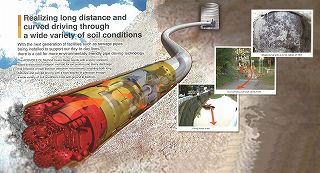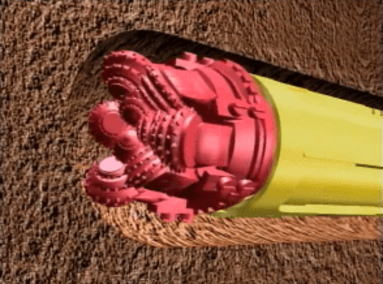MicrotunnelingSERVICE&PRODUCTS
What is Microtunneling Work?

「Characteristics and benefits of Microtunneling work」
Most infrastructure equipment (electricity, gas, water supply, communication,
etc.) required for living is buried underground, and these pipelines are
excavated and buried in a special way, which is essential for city life.The
construction method that is largely supporting these works is called Microtunneling
work .
Features and Benefits
By simply installing the starting shaft and the arrival shaft at each end of the construction section, the impact of traffic regulation, noise, vibration and dust on the urban environment during the construction period can be minimized.

Ace-mole method
"Drilling and forced-feed/discharging system"
It is a system in which additives are injected into excavated earth and sand, mud is turned into mud, and the soil is forcibly fed and discharged to and from a shaft.
Feature
long distance… Proprietary drilling and soil removal mechanisms enable
long-distance propulsion from soft soil to rock bedrock
Curve… Lead direction correction mechanism and precision position measurement
system enable curve propulsion Support for small
shaft… By dividing the leading body, it can start and reach from a small
circular shaft of φ2・.0m and φ2・5m.

「EXCAVATION AND FORCE-FEEDING AND REMOVING MECHANISM OF MUDDY SOIL PRESSURE TYPE」
A system in which an additive is injected into excavated earth and sand and mud is converted into mud and the soil is forcibly fed and discharged to and from a shaft
Additives are ejected from the tip and injected into the working face to line the cutter head.
Convert excavated sediment into water-cut and fluid mud (slurry).
Excavated earth and sand which have become mud is transferred to the rear along the outer peripheral surface of the leading body, a part of the excavated earth and sand is taken in, and the soil is forcibly fed and discharged to the starting shaft through a soil discharge pipe by a force feed pump.
A part of the mud is left in the natural ground by controlling the intake amount of the mud to prevent collapse of the working face and the pit wall, and the propulsion force is reduced by the sliding material effect of the mud (slurry).
aaaaaaaaaaaaaaaaaaaaaaaaaaaaaaaaaaaaaaaaaaaaaaaaaaaaaaaaAceMole catalogue
Work situation
Work photo


